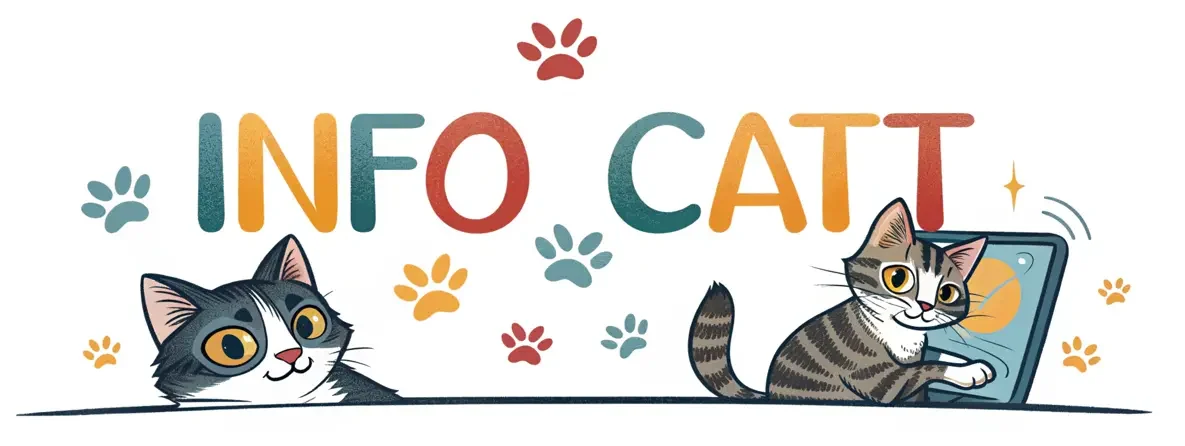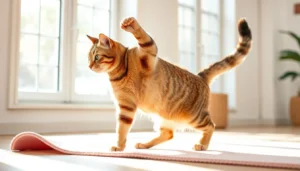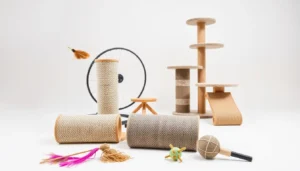Every cat owner dreams of having a healthy, strong feline friend. When I first saw my rescue cat’s lean frame, I wanted to help her get stronger. Building muscle is not just about looks. It’s about making your pet healthier and more vibrant.
Cat strength training is more than a trend. It’s a way to improve your cat’s overall health. By learning how to make a cat muscular, you can help your pet gain lean muscle, more energy, and better mobility.
This guide will show you how to help your cat build muscle. Whether your cat is sedentary or active, we have practical tips to support their health.
Understanding Your Cat’s Natural Physique and Muscle Development
To build muscle in cats, you need to know their unique body types. Cats are naturally athletic and have different body shapes. These shapes affect how they can build muscle.
Every cat has a special body type that affects muscle growth. Some breeds build muscle easily, while others need special help.
👉 Different Cat Body Types and Muscle Potential
Cat body types vary a lot, which changes their muscle-building potential:
- Muscular breeds like Bengal and Siberian cats build muscle easily
- Lean breeds such as Siamese need special muscle-building plans
- Mixed-breed cats have their own muscle-building traits
👉 Age and Breed Considerations for Muscle Building
Your cat’s age is key for muscle growth. Young cats build muscle faster, while older cats need more care.
“Understanding your cat’s individual physique is key to effective muscle development.” – Veterinary Muscle Health Expert
👉 Signs of Healthy Muscle Development
Look for these signs when trying to build muscle in cats:
- Increased muscle tone and definition
- Improved strength and energy
- Stable weight
- Enhanced flexibility and movement
Remember, every cat is different. Always put your pet’s health first when building muscle.
Essential Nutrients for Building Cat Muscle Mass
To build muscle in cats, you need a smart nutrition plan. Your cat’s diet is key for muscle growth and weight gain. High-protein cat food is essential for strong, lean muscles.
Important nutrients for muscle growth include:
- Animal-based proteins with complete amino acid profiles
- Essential amino acids like taurine and arginine
- Omega-3 fatty acids for muscle recovery
- Vitamin D and B-complex vitamins
When choosing high-protein cat food, pick options with real meat first. Chicken, turkey, and fish are great for muscle building. Look for foods with at least 40% protein to help your cat gain healthy weight.
Pro tip: Consult with your veterinarian to create a personalized nutrition plan tailored to your cat’s specific muscle-building needs.
Add lean protein like cooked chicken or fish to your cat’s diet. Stay away from too many carbs, as they can slow muscle growth. Balanced nutrition is vital for your cat’s muscle growth and health.
How To Make A Cat Muscular Through Exercise and Play
To build muscle in cats, you need a good exercise plan. This plan should keep your cat active and engaged. It also helps improve their fitness and strengthens your bond.
Cats are natural athletes with great muscle-building potential. The trick is to find exercises that fit their unique personality and energy.
Safe Indoor Exercise Activities
Building muscle indoors doesn’t need fancy gear. Try these fun activities:
- Interactive wand toys for jumping and chasing
- Laser pointer sessions that encourage quick movements
- Climbing cat trees with multiple levels
- Hide-and-seek games using treats as motivation
Outdoor Activities for Muscle Building
For cats with outdoor access, nature is perfect for building muscle:
- Controlled leash walks in safe environments
- Exploring garden spaces with obstacles
- Climbing supervised tree branches
Exercise Duration and Frequency Guidelines
Your cat’s workout plan should fit their needs. Aim for 10-15 minutes of active play, 2-3 times daily. Watch for signs of tiredness and always check with your vet before starting new exercises.
Remember, consistency is more important than intensity in your cat’s muscle-building journey.
Creating the Perfect High-Protein Diet Plan
Creating the right diet is key for your cat’s muscle growth and healthy weight. High-protein cat food is essential for muscle support and fitness. Every cat is different, so making the perfect diet needs careful thought.
When picking high-protein cat food, look for quality protein sources. Choose foods with:
- Real meat as the first ingredient
- Minimal grain or filler content
- Balanced nutritional profile
- Age-appropriate protein levels
Figuring out your cat’s protein needs depends on their weight, age, and activity level. Veterinarians often recommend 35-45% of total diet for muscle-building cats. Foods for healthy weight gain usually have the right amount of protein for muscle growth.
Pro tip: Gradually introduce new high-protein foods to prevent digestive issues and ensure your cat’s acceptance.
It’s wise to talk to your vet for a custom nutrition plan. They can figure out the right protein for your cat’s body and goals. Keeping an eye on your cat’s progress and adjusting the diet helps with healthy weight gain and muscle growth.
Safe Training Equipment and Cat Exercise Tools
Setting up a good place for cat strength training needs careful choice of gear. Your cat’s workout plan should include fun items that help build muscles safely and happily.
Choosing the right tools can turn your home into a place for cats to get fit. It’s important to pick items that fit your cat’s natural ways and abilities.
Best Cat Trees for Climbing Exercises
Cat trees are key for cat strength training. Look for features that help build muscles:
- Multiple levels with varying heights
- Sturdy platforms for jumping and climbing
- Rough surfaces that provide grip
- Vertical poles for stretching and climbing
Interactive Toys for Strength Building
Your cat’s workout plan should include toys that challenge their mind and body:
- Laser pointers for quick, intense movements
- Feather wands for jumping exercises
- Puzzle toys that require physical manipulation
- Hanging toys that encourage reaching and stretching
Safety Considerations for Exercise Equipment
When starting a cat strength training routine, safety first. Check toys often for damage. Make sure all gear is stable and won’t fall over during play. Stay away from small parts that could be choking hazards.
Remember, each cat is unique. Observe your cat’s preferences and adapt your workout plan to fit them.
Monitoring Your Cat’s Progress and Health
Watching your cat build muscle is a big job. It needs careful watching and help from experts. Your cat’s muscles growing is a special process that needs constant checking and focus.
When you’re helping your cat get fit, keep an eye on a few important things:
- Visual body condition assessments
- Regular weight measurements
- Muscle tone and definition evaluation
- Energy level observations
To really see how your cat is getting stronger, start with some basic steps. Use a soft measuring tape to measure:
- Chest circumference
- Leg muscle density
- Overall body weight
Getting your vet involved is key to tracking muscle growth. They can tell if your cat is getting stronger the right way or if there’s a problem. Make sure to check in with your vet every few months to keep your cat’s workout safe and working well.
Remember: Every cat’s muscle-building journey is unique and requires personalized attention.
Look out for signs that something might be off during your cat’s workout. These include:
- Sudden weight changes
- Decreased mobility
- Changes in appetite
- Unusual lethargy
Keeping a close eye on your cat’s progress lets you tweak their workout plan. This way, you can keep them healthy and fit as they change.
Common Mistakes to Avoid When Building Cat Muscle
Creating a cat exercise routine needs careful planning. It’s important to know the mistakes that could stop your fitness goals.
Building muscle in cats is more than just hard workouts and lots of protein. Many cat owners accidentally make mistakes that can hurt their pet’s health and muscle growth.
👉 Dietary Dangers to Dodge
Feeding too much is a common mistake when trying to build cat muscle. Focus on good nutrition, not just how much you feed. Here are some diet mistakes to avoid:
- Giving too many treats that have no nutritional value
- Not understanding how much protein your cat needs
- Ignoring the need for balanced nutrition
👉 Exercise-Related Errors
Your cat’s exercise routine must be well-planned. Too much exercise can cause injuries or make your cat not want to move. Here are some common mistakes:
- Using the wrong exercise equipment
- Forcing your cat to exercise for too long
- Not considering your cat’s fitness level
👉 Recognizing Overexertion Signs
Cats show tiredness in different ways than humans. Look for small signs that your cat might be too tired:
- Less interest in playing
- Being unusually tired
- Showing discomfort when moving
Remember, building muscle is a slow process. It takes patience and understanding your cat’s body.
Conclusion
Building muscle for your cat is a rewarding journey that needs dedication and patience. The tips we’ve shared offer a clear path to help your cat get stronger and healthier. Remember, every cat is different, so the way to make them muscular will vary.
Focus on a balanced diet, exercise, and regular vet visits to succeed. Start with small steps and watch how your cat responds. Regular vet check-ups will help you make sure you’re on the right path.
The aim is more than just muscle. It’s about improving your cat’s health and happiness. By following this guide, you’ll not only build muscle but also boost your cat’s life quality. Be patient, watch your cat grow stronger, and enjoy the journey.
With the right knowledge and care, you can help your cat build muscle safely. Trust the process, celebrate small wins, and always put your cat’s health first.
FAQ
How long does it take to see muscle development in my cat?
It takes 6-12 weeks of regular exercise and good food for cats to build muscle. You might see small changes in 4-6 weeks. But, bigger changes will show after 2-3 months of working on it.
Is it safe to build muscle in older cats?
Older cats can build muscle, but you need to be careful. Talk to your vet first. Start with easy exercises and choose low-impact activities. They might have joint problems or health issues that need special care.
What type of protein is best for cat muscle growth?
Cats need animal-based proteins for muscle growth. Choose cat foods with real meat like chicken, turkey, or fish. These foods have the amino acids cats need for muscles and health.
How much exercise does my cat need to build muscle?
Cats need 15-30 minutes of play each day. Break it into 2-3 short sessions to keep them interested. Use toys, climbing, and chase games for a good workout.
Can indoor cats build muscle effectively?
Yes! Indoor cats can get fit with creative play. Use toys like feather wands and laser pointers. Make your home fun with climbing trees and puzzle feeders for regular play.
Are there any risks to muscle-building activities for cats?
Muscle building is mostly safe, but there are risks. Too much exercise or sudden diet changes can hurt them. Start slow, watch how they react, and talk to your vet for a safe plan.
How can I tell if my cat is gaining muscle versus fat?
Look for firmer muscles, more strength, and better body shape. Muscle gain means more defined muscles, such as in the shoulders and back. Your vet can tell the difference with a body condition score.
What are the best exercises for cat muscle building?
Great exercises include climbing, playing with wand toys, chasing laser pointers, and jumping. Puzzle feeders also work well. These activities work many muscles and keep your cat’s mind sharp.
Can all cat breeds build muscle equally?
No, different breeds build muscle differently. Some, like Bengals and Maine Coons, are naturally better at it. Smaller breeds might need special plans. Always think about your cat’s breed and talk to a vet.
How important is diet in cat muscle development?
Diet is very important for muscle growth. Cats need high-protein foods and balanced nutrition. Look for foods with at least 40% protein. Your vet might also suggest supplements for muscle growth and health.



